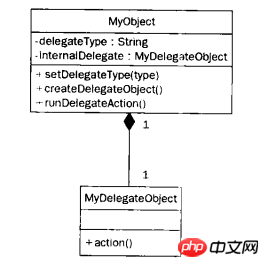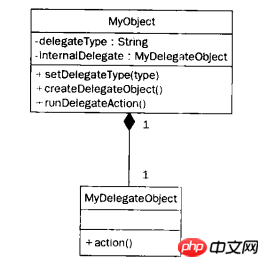 Backend Development
Backend Development
 PHP Tutorial
PHP Tutorial
 PHP object-oriented advanced design patterns: Delegation pattern usage examples
PHP object-oriented advanced design patterns: Delegation pattern usage examples
PHP object-oriented advanced design patterns: Delegation pattern usage examples
One of the most powerful features of object-oriented programming is its dynamic nature. In a world of ever-increasing functionality, hybrid building structures, and evolving standards, dynamic code takes on a whole new meaning. Whether it's a new file storage standard or a streaming standard, a social networking site or something new with an Internet pioneer API, Web programming is constantly changing. Traditional ways of approaching sentencing are no longer effective today when faced with the vast number of options available. By moving intelligent objects into appropriate locations, the delegate design pattern takes away from complex decisions.
What is the delegation pattern?
The delegation design pattern removes decisions and complex functionality from core objects by assigning or delegating to other objects.
Delegation pattern application problems and solutions
Most PHP programmers’ initial contact is almost with the programmatic programming type. This programming style relies heavily on flow control based on conditional statements. Object-oriented programming provides some alternatives to traditional conditional statements, thereby creating a more stateful code flow. One way to achieve this functionality is to create objects based on the delegate design pattern.
The Delegate design pattern strives to remove complexity from core objects. At this point we are not designing objects that rely heavily on performing specific functionality by evaluating conditional statements; objects based on the delegation pattern can delegate decisions to different objects. Delegation can be as simple as using an intermediate object to handle a decision tree, or as complex as using a dynamically instantiated object to provide the desired functionality.
It is very important not to think of the delegate design pattern as a direct competitor to conditional statements. In contrast, the Delegate design pattern helps structure the architecture by invoking the correct functionality without requiring conditional statements. The conditional statement is best located in the actual method, and the processing of the business rules is completed in the method.
An example of using the delegate design pattern is to provide multiple formats for a specific part of data. Suppose there is an archive in an open source code repository. When visitors intend to download a portion of the source code, they can choose between two different file formats. The specified file will be compressed and sent to the browser. In this example, I intend to take files in zip and tgz compressed formats.
When an object contains complex but independent pieces of functionality that must be executed based on decisions, the best practice is to use objects based on the delegate design pattern.
##UML
This UML diagram details a class design using the delegate design pattern.

<?php
//委托模式-去除核心对象中的判决和复杂的功能性
//使用委托模式之前,调用cd类,选择cd播放模式是复杂的选择过程
class cd {
protected $cdInfo = array();
public function addSong($song) {
$this->cdInfo[$song] = $song;
}
public function playMp3($song) {
return $this->cdInfo[$song] . '.mp3';
}
public function playMp4($song) {
return $this->cdInfo[$song] . '.mp4';
}
}
$oldCd = new cd;
$oldCd->addSong("1");
$oldCd->addSong("2");
$oldCd->addSong("3");
$type = 'mp3';
if ($type == 'mp3') {
$oldCd->playMp3();
} else {
$oldCd->playMp4();
}<?php
//委托模式-去除核心对象中的判决和复杂的功能性
//改进cd类
class cdDelegate {
protected $cdInfo = array();
public function addSong($song) {
$this->cdInfo[$song] = $song;
}
public function play($type, $song) {
$obj = new $type;
return $obj->playList($this->cdInfo, $song);
}
}
class mp3 {
public function playList($list) {
return $list[$song];
}
}
class mp4 {
public function playList($list) { return $list[$song];
}
}
$newCd = new cd;
$newCd->addSong("1");
$newCd->addSong("2");
$newCd->addSong("3");
$type = 'mp3';
$oldCd->play('mp3', '1'); //只要传递参数就能知道需要选择何种播放模式The above is the detailed content of PHP object-oriented advanced design patterns: Delegation pattern usage examples. For more information, please follow other related articles on the PHP Chinese website!

Hot AI Tools

Undresser.AI Undress
AI-powered app for creating realistic nude photos

AI Clothes Remover
Online AI tool for removing clothes from photos.

Undress AI Tool
Undress images for free

Clothoff.io
AI clothes remover

Video Face Swap
Swap faces in any video effortlessly with our completely free AI face swap tool!

Hot Article

Hot Tools

Notepad++7.3.1
Easy-to-use and free code editor

SublimeText3 Chinese version
Chinese version, very easy to use

Zend Studio 13.0.1
Powerful PHP integrated development environment

Dreamweaver CS6
Visual web development tools

SublimeText3 Mac version
God-level code editing software (SublimeText3)

Hot Topics
 1387
1387
 52
52
 PHP Advanced Features: Best Practices in Object-Oriented Programming
Jun 05, 2024 pm 09:39 PM
PHP Advanced Features: Best Practices in Object-Oriented Programming
Jun 05, 2024 pm 09:39 PM
OOP best practices in PHP include naming conventions, interfaces and abstract classes, inheritance and polymorphism, and dependency injection. Practical cases include: using warehouse mode to manage data and using strategy mode to implement sorting.
 The difference between design patterns and architectural patterns in Java framework
Jun 02, 2024 pm 12:59 PM
The difference between design patterns and architectural patterns in Java framework
Jun 02, 2024 pm 12:59 PM
In the Java framework, the difference between design patterns and architectural patterns is that design patterns define abstract solutions to common problems in software design, focusing on the interaction between classes and objects, such as factory patterns. Architectural patterns define the relationship between system structures and modules, focusing on the organization and interaction of system components, such as layered architecture.
 In-depth understanding of PHP object-oriented programming: Debugging techniques for object-oriented programming
Jun 05, 2024 pm 08:50 PM
In-depth understanding of PHP object-oriented programming: Debugging techniques for object-oriented programming
Jun 05, 2024 pm 08:50 PM
By mastering tracking object status, setting breakpoints, tracking exceptions and utilizing the xdebug extension, you can effectively debug PHP object-oriented programming code. 1. Track object status: Use var_dump() and print_r() to view object attributes and method values. 2. Set a breakpoint: Set a breakpoint in the development environment, and the debugger will pause when execution reaches the breakpoint, making it easier to check the object status. 3. Trace exceptions: Use try-catch blocks and getTraceAsString() to get the stack trace and message when the exception occurs. 4. Use the debugger: The xdebug_var_dump() function can inspect the contents of variables during code execution.
 Analysis of the Decorator Pattern in Java Design Patterns
May 09, 2024 pm 03:12 PM
Analysis of the Decorator Pattern in Java Design Patterns
May 09, 2024 pm 03:12 PM
The decorator pattern is a structural design pattern that allows dynamic addition of object functionality without modifying the original class. It is implemented through the collaboration of abstract components, concrete components, abstract decorators and concrete decorators, and can flexibly expand class functions to meet changing needs. In this example, milk and mocha decorators are added to Espresso for a total price of $2.29, demonstrating the power of the decorator pattern in dynamically modifying the behavior of objects.
 The wonderful use of the adapter pattern in Java design patterns
May 09, 2024 pm 12:54 PM
The wonderful use of the adapter pattern in Java design patterns
May 09, 2024 pm 12:54 PM
The Adapter pattern is a structural design pattern that allows incompatible objects to work together. It converts one interface into another so that the objects can interact smoothly. The object adapter implements the adapter pattern by creating an adapter object containing the adapted object and implementing the target interface. In a practical case, through the adapter mode, the client (such as MediaPlayer) can play advanced format media (such as VLC), although it itself only supports ordinary media formats (such as MP3).
 PHP Design Patterns: Test Driven Development in Practice
Jun 03, 2024 pm 02:14 PM
PHP Design Patterns: Test Driven Development in Practice
Jun 03, 2024 pm 02:14 PM
TDD is used to write high-quality PHP code. The steps include: writing test cases, describing the expected functionality and making them fail. Write code so that only the test cases pass without excessive optimization or detailed design. After the test cases pass, optimize and refactor the code to improve readability, maintainability, and scalability.
 Application of design patterns in Guice framework
Jun 02, 2024 pm 10:49 PM
Application of design patterns in Guice framework
Jun 02, 2024 pm 10:49 PM
The Guice framework applies a number of design patterns, including: Singleton pattern: ensuring that a class has only one instance through the @Singleton annotation. Factory method pattern: Create a factory method through the @Provides annotation and obtain the object instance during dependency injection. Strategy mode: Encapsulate the algorithm into different strategy classes and specify the specific strategy through the @Named annotation.
 What are the advantages and disadvantages of using design patterns in java framework?
Jun 01, 2024 pm 02:13 PM
What are the advantages and disadvantages of using design patterns in java framework?
Jun 01, 2024 pm 02:13 PM
The advantages of using design patterns in Java frameworks include: enhanced code readability, maintainability, and scalability. Disadvantages include complexity, performance overhead, and steep learning curve due to overuse. Practical case: Proxy mode is used to lazy load objects. Use design patterns wisely to take advantage of their advantages and minimize their disadvantages.



